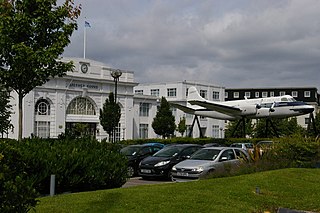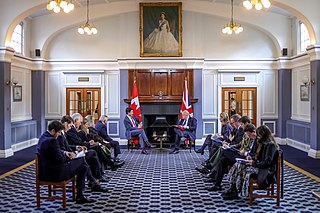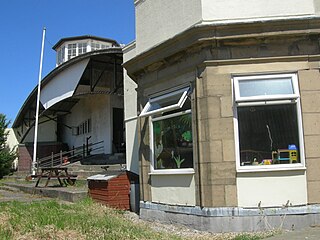
Heathrow or Heath Row was a wayside hamlet along a minor country lane called Heathrow Road in the ancient parish of Harmondsworth, Middlesex, England, on the outskirts of what is now Greater London. Its buildings and all associated holdings were demolished, along with almost all of the often grouped locality of The Magpies in 1944 for the construction of the new London Airport, which would later assume the name of Heathrow after 1967.

Croydon Airport was the UK's only international airport during the interwar period. It opened in 1920, located near Croydon, then part of Surrey. Built in a Neoclassical style, it was developed as Britain's main airport, handling more cargo, mail, and passengers than any other UK airport at the time. Innovations at the site included the world's first air traffic control and the first airport terminal. During World War II the airport was named RAF Croydon as its role changed to that of a fighter airfield during the Battle of Britain; and in 1943 RAF Transport Command was founded at the site, which used the airport to transport thousands of troops into and out of Europe.

Royal Air Force Northolt or more simply RAF Northolt is a Royal Air Force station in South Ruislip, 2 nautical miles from Uxbridge in the London Borough of Hillingdon, western Greater London, England, approximately 6 mi (10 km) north of Heathrow Airport. As London VIP Airport, the station handles many private civil flights in addition to Air Force flights.

Nottingham Airport, also known as Nottingham City Airport, is located in Tollerton, Nottinghamshire, England. It is situated 3 nautical miles south east of Nottingham City Centre, and signposted on the A52 at Trent Bridge and on the A606—this makes it one of the closest airports to a city centre in the UK. The aerodrome is equipped for private aviation, business aviation and flight instruction.

Barton Aerodrome is an airport in Barton-upon-Irwell, Greater Manchester, England, 5 nautical miles west of Manchester. Formerly known as City Airport and City Airport Manchester, It is known by the Civil Aviation Authority (CAA) as Manchester/Barton and rebranded as Manchester Barton Aerodrome on 3rd April 2023.
RAF Ringway was a Royal Air Force satellite station at Ringway, Cheshire, England, near Manchester. It was operational from 1939 until 1957. The site is now occupied by Manchester Airport.

White Waltham Airfield is an operational general aviation aerodrome located at White Waltham, 2 nautical miles southwest of Maidenhead, in the Royal Borough of Windsor and Maidenhead in Berkshire, England.

Caernarfon Airport, is a general aviation airport located 4 nautical miles southwest of Caernarfon, Gwynedd, Wales. It is on the site of the former RAF Llandwrog which was operational between 1941 and 1946. From the end of the 1960s, civil light aircraft started to use the aerodrome in greater numbers and eventually gained a full operating licence in 1976.

Heston Aerodrome was an airfield located to the west of London, England, operational between 1929 and 1947. It was situated on the border of the Heston and Cranford areas of Hounslow, Middlesex. In September 1938, the British Prime Minister, Neville Chamberlain, flew from Heston to Germany three times in two weeks for talks with Adolf Hitler, and returned to Heston from the Munich Conference with the paper referred to in his later "Peace for our time" speech from 10 Downing Street.

The Fairey Hendon was a British monoplane, heavy bomber of the Royal Air Force, designed by Fairey Aviation, and first flown in 1930. The aircraft served in small numbers with one squadron of the RAF between 1936 and 1939. It was the first all-metal construction low-wing monoplane to enter service with the RAF.

Sir Charles Richard Fairey, also known as Richard Fairey, was an English aircraft manufacturer.
National Aircraft Factory No. 2 was a World War I UK government owned aircraft factory located at Heaton Chapel, Stockport. It produced over 450 warplanes during 1918/19. The Heaton Chapel factory was then sold to Crossley Motors, who used it for building motor vehicles. In 1934, it was sold to the Fairey Aviation Company, with aircraft production there continuing until the late 1950s.

Stanley Park Aerodrome was an airfield located in the Stanley Park area of Blackpool, Lancashire, England. It was also known as Blackpool Municipal Airport, and was in use for civil and military flying from 1929 until closure of the airfield in 1947. The site is now used by Blackpool Zoo.

London Air Park, also known as Hanworth Air Park, was a grass airfield in the grounds of Hanworth Park House, operational 1917–1919 and 1929–1947. It was on the southeastern edge of Feltham, now part of the London Borough of Hounslow. In the 1930s, it was best known as a centre for private flying, society events, visits by the Graf Zeppelin airship, and for aircraft manufacture by the Whitehead Aircraft Company during World War I and General Aircraft Limited (GAL) 1934–1949; in total over 1,650 aircraft were built here.

Hounslow Heath Aerodrome was a grass airfield, operational 1914–1920. It was in the London borough of Hounslow, and hosted the British Empire's first scheduled daily international commercial flights, in 1919. The site today includes the main remaining part of Hounslow Heath.
In its early years what is now Heathrow Airport was the Great West Aerodrome, sometimes known as Heathrow Aerodrome.

The origins of Manchester Airport in England, UK, date back to the 1930s. Construction started on Ringway on 28 November 1935 and it opened partly in June 1937 and completely on 25 June 1938, in Ringway parish north of Wilmslow, from which it derived its original name Manchester (Ringway) Airport. Its north border was Yewtree Lane. Its southeast border was a little northwest of Altrincham Road (Styal).
The metropolitan area of London, England, United Kingdom, is served by six international airports and several smaller airports. Together, these airports constitute the busiest airport system in the world by passenger numbers and the second-busiest by aircraft movements.
Walsall Aerodrome, also known as Walsall Airport, Walsall Municipal Airport, and later as Walsall Aldridge Airport was an airport at Aldridge, Staffordshire, England, serving the town of Walsall, north Birmingham, Sutton Coldfield and Lichfield. It operated from the 1930s–1956.

This is an event timeline and minor geographical information about Heathrow hamlet.
















